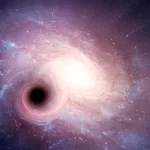Key Takeaways:
- Discovery of ancient galaxies challenges understanding of early universe.
- New findings suggest supermassive black holes may have fed on cosmic web filaments.
- Galaxies observed are among the faintest ever seen, hinting at more hidden in the area.
- Dark matter’s role in forming structures like black holes remains a mystery.
- Study offers insights into early universe evolution and formation of celestial bodies.
Astronomers unearthed a cluster of six galaxies, hailing from the earliest epoch of the cosmos, obstructing a gargantuan black hole.
For an extensive period, astronomers grappled with comprehending the genesis of supermassive black holes during the nascent stages of the universe. They are cognizant that these celestial behemoths necessitated rapid expansion to attain their monumental stature promptly (within roughly 1 billion years post-Big Bang). Nonetheless, the precise reservoirs from which they amassed colossal amounts of matter remain enigmatic. Presently, novel revelations from the European Southern Observatory’s Very Large Telescope (VLT), disclosed on October 1 in Astronomy & Astrophysics, may furnish elucidation.
The sextet of ancient galaxies recently unveiled dwell within an expansive expanse of gas—spanning approximately 300 times the breadth of the Milky Way—and were discerned owing to protracted observations conducted by the VLT. Following a meticulous analysis of the data, the investigators concluded that they beheld these galaxies as they existed a mere 900 million years after the Big Bang, during a juncture when the universe was scarcely 6 percent of its current age. This constitutes the inaugural instance wherein such an intimate assemblage of galaxies has been detected within the initial billion years of cosmic evolution.
Moreover, nestled within the heart of this galactic congregation resides a supermassive black hole, boasting a mass roughly equivalent to 1 billion solar masses. “[The existence of supermassive black holes in the early universe] represents an enigmatic phenomenon, and thus far, we have lacked a cogent rationale for their presence,” remarked principal investigator Marco Mignoli in a statement released by ESO.
Nourishing a black hole
Scientists acknowledge the existence of a threshold dictating the pace at which a black hole can burgeon: the Eddington limit. However, while this threshold plays a role in the formation of supermassive black holes during the cosmic dawn, the quandary confronting scientists pertains to the origin of sustenance for early black holes.
The crux likely hinges on the cosmic web, an omnipresent framework interwoven throughout the cosmos, interconnecting remote galaxies, galaxy clusters, and superclusters via tenuous threads of gas known as filaments.
The researchers behind the recent study posit that their supermassive black hole and its encompassing galaxies, christened SDSS J1030+0524, likely feasted upon the reservoir of gas ensconced within a convoluted nexus of cosmic web filaments.
“The cosmic web filaments resemble strands of a spider’s web,” elucidated Mignoli. “Galaxies congregate and proliferate at the nexus of these filaments, while streams of gas—accessible to nourish both galaxies and the central supermassive black hole—can traverse along these filaments.”
However, this merely defers the inquiry further. How did these filaments initially acquire their gas? Astronomers speculate that the answer might be intertwined with another longstanding astronomical enigma: dark matter.
In the embryonic stages of the universe, ordinary matter remained excessively hot to coalesce and form gravitationally bound entities such as black holes and galaxies. However, researchers postulate that dark matter could have been substantially colder than ordinary matter. Consequently, dark matter could have aggregated during the early cosmos, coalescing into colossal structures known as dark matter halos. The gravitational influence exerted by these obscure structures would have subsequently attracted ordinary matter, amassing copious quantities of gas conducive to the inception of the first galaxies and black holes.
The galaxies unearthed in this recent investigation also rank among the dimmest ever observed, suggesting the potential existence of numerous concealed entities in the vicinity.
“We posit that what we have perceived thus far around this supermassive black hole merely scratches the surface, and that the handful of galaxies discovered are merely the most luminous ones,” remarked co-author Barbara Balmaverde.



Thank you for creating such valuable content. Your hard work and dedication are appreciated by so many.
Your posts always provide me with a new perspective and encourage me to look at things differently Thank you for broadening my horizons